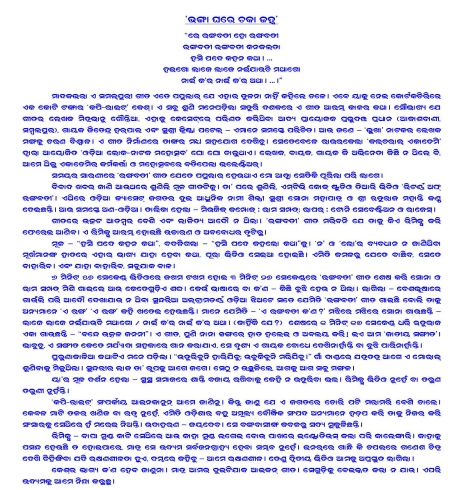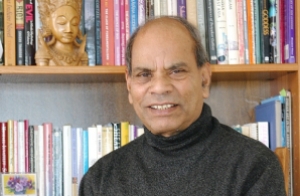Subhas Chandra Pattanayak
Sasnkaracharya Nishchalananda Saraswati has again spewed venom at the State administration in a press conference at Bhubaneswar.
He has been insisting that management of SriJagannatha should vest in him and the Temple must run under his direction. He claims to be the supreme authority on Temple administration and by not consulting him, the chief administrator of the Temple has generated all the chaos.
He has tried to create panic in public mind by predicting severe disaster, as Daru selection to Brahma Paribarttan having generated wrath of the God Almighty, the Ratha Yatra would bring in catastrophe.
He has come down heavily on Chief Minister Naveen Patnaik over his silence on popular demand to punish the Daitas for irregularities in Brahma transfer. He has been demanding that the law of Jagannatha Temple Administration be amended obviously to quash the primacy of the Daitas in the Lord’s most important function spanning from Snana Yatra to Ratha Yatra including Navakalebar.
We have exposed in these pages the modus operandi of Nishchalanand and how for fulfilling his ambition, agent provocateurs were engaged to mar the sanctity of Brahma transfer. But Nishchalananda is silent about the agent provocateurs.
Daitas have been subjected to humiliation and motivated media reprimands so that environment to hand over SriMandira to Sankaracharya could be easier.
Religious revivalists’ demand for handing over the responsibility of SriMandira to Sankaracharya makes the matter clear. Wordy arsenals used against the Daitas in television and social media, read with Sankaracharya’s statements so far, provokes us to fear that Nischchalananda is the main designer of the Navakalebara fiasco. He can go to any extent in his design to grab SriMandira in order to promulgate rabid Brahminism to oblige religious revivalists.
The temple of Jagannatha has remained till date a citadel of applied Buddhism where the Brahmins have secondary role and Sankaracharya has no role to play. But eliminating Jagannatha’s Buddhist relevance is the only purpose of Sankaracharya.
Sri Kedarnath Mohapatra in his Khurudha Itihasa has clearly noted that the sole purpose of Sankara in establishing Gobardhana Matha at Puri and appointing his chela order in the said Matha is revival of Brahminism. To quote him: SE BRAHMANYA DHARMARA PRATIPATTI O PRASARA BRUDDHI NIMITTA PURIRE GOBARDDHAN PITHA PRATISTHA KARI TANKARA PRIYA SHISHYA PADMAPADACHARYANKU EHARA PRATHAMA PITHADHISHA RUPE NIJUKTA KARITHILE. (Page 287 of Khurudha Itihasa, 1969, published with the funds granted by Government of Orissa). Roughly it means: Adi Sankara had established Gobarddhana Pitha at Puri and appointed his dear disciple Padmapadacharya as the first chief of this center of his order in order only to revive the supremacy of Brahmanism and spread it in Orissa.
The only work of this Matha was to train the Brahmins in how to vitiate Jagannatha’s worship with Vedic method to eliminate the original method of his worship in Sabari Tantra or Bouddha Tantra.
In recording this evil design, Prof. K. C. Mishra has noted, “The priests of Jagannatha Temple learn the art of ritualistic worship from the (Sankaracharya) Matha”.
Needless to say that, the priests are the Brahmins appointed by patron kings of Brahminism, whose training was vested in Sankaracharya. One of these kings had even cooperated with the Brahmins to establish the statues of Adi Sankara and his first chela Padmapada on the Ratna Singhasana of Jagannatha. Those two statues were being worshiped along with the Lord in naked assertion of the authority of the caste-supremacists. People of Orissa had revolted against this mischief and had dragged those statues out of the Ratna Singhasana and had thrown them to the street for people to pulverize them to dust under their feet.
Though Khurudha Itihasa attributes this to Chaitanya’s movement (page 288), the fact that, under autocratic rule of the then Gajapati king, this deracination of Sankaracharya-statues from Jagannatha’s Ratna Singhasana had happened, is no small admission of history that people of Orissa had freed the Jagannatha Temple from the evil design of Sankaracharya in a heroic fight against their own king.
Since then, Sankaracharya has been kept out of Srimandira.
In recording this, Prof. Mishra writes, “The system (of training priests by Sankaracharya) is no longer in vogue in the temple” (K.C. Miashra, The Cult of Jagannatha, page 125)
This being the reality, Nishchalananda’s claim of authority on Jagannatha system is nothing but impudence.
He and the Brahmin officials in nexus with him have cunningly created chaos in this Navakalebar. Gajapati has acted a patron of Brahminism by being hand-in-glove with Nishalananda.
As there is every logical reason to apprehend that he may use any further tricks to derail the smooth performance of the Car Festival, so that the religious revivalists would get new grounds to demand for handing over the SriMandira to Sankaracharya in order to extinguish applied Buddhism in vogue in the Temple system, it is necessary that the Crime Branch be asked to study all his statements – print and visual – on records so far, and to take necessary precautionary steps to ensure the Ratha Yatra completing the cycle peacefully.
He should be arrested if his tongue is not tamed. Jagannatha culture is to be preserved at any cost.




